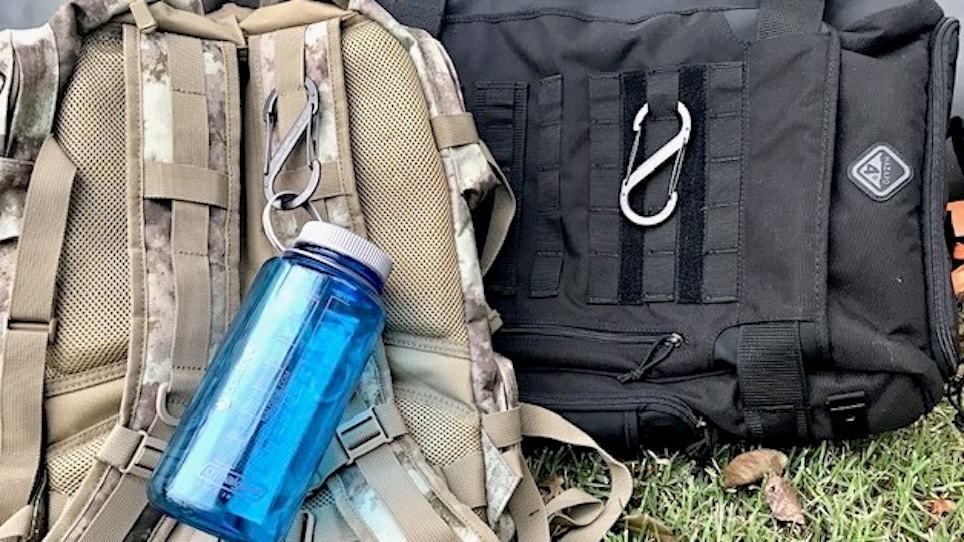
The Modular Lightweight Load Carrying Equipment — commonly known as MOLLE — is standard in the U.S. Department of Defense for military use. It's been adopted in the civilian market for backpacks, laptop bags, luggage and other items, giving everyday consumers the chance to add items for travel, hunting, range time, hiking, backpacking or other uses. (Photo: Alan Clemons)
The Modular Lightweight Load Carrying Equipment, or MOLLE, system is standard issue across the Department of Defense. However, there is often confusion over the term MOLLE and what it actually means.
It’s the first system to be called modular, but adding or subtracting equipment to the soldier’s load has been standard for more than a century. The M1910 system used a cotton webbing pistol belt with rows of grommets along its length. This simple system was used through both World Wars.
In 1956, came a new system named, “Belt, Individual Equipment.” M1956 gear retained the cotton canvas pistol belt construction, but introduced a metal clasp called a slide fastener to attach pouches to the belt, or similar width strips of webbing on packs.
During the Vietnam War, an interim system called M1967 Modernized Load Carrying Equipment (MLCE) introduced nylon construction to further improve durability and reduce water retention. It continued using the slide fastener attachment.
At the end of the war, M1967 was displaced by All-Purpose Lightweight Individual Carrying Equipment (ALICE). Further improvements were made over the next two decades.
The late 1980s saw the development of the Individual Integrated Fighting System (IIFS). That was the first introduction of a standard issue load-bearing vest that moved the weight of the load to the soldier’s upper torso. Other IIFS components included an internal frame field pack and a multipurpose shelter system.
In the mid-1990s, a Natick Soldier Systems employee named John Kirk developed a replacement for the slide fastener. Made from nylon webbing, this new development was called the Pouch Attachment Ladder System (PALS). Resembling a grid-like structure of 1-inch nylon webbing, similar straps were added to the back of a pouch and woven into the vest or pack. A snap at the end of the strap kept it from backing out.
PALS became the patented attachment standard, and around it an entire load carriage system that we now know as MOLLE was designed. Like IIFS, MOLLE was centered around a vest, called the Fighting Load Carrier (FLC).
What Happened Next?
Initially, MOLLE was adopted by the Marine Corps, but it quickly encountered issues. The initial pack design connected to the waist belt also carried ammunition and other pouches. In the past, the Marine had two separate belts for those purposes and the so-called probe and socket interface that connected the pack frame to the belt proved difficult to use. Additionally, Marines were handed a bag pull of pouches and a VHS video tape explaining how to put it all together. Complaints from the fleet were rampant.
In 1999, the Army performed a limited fielding of MOLLE to the Ranger Regiment, leveraging lessons learned from the Marines. The pack featured an integrated waist belt and Natick developed a modular chest rig called the Ranger Assault Carry Kit (RACK). Not long after, full fielding commenced and the Army instituted a train-the-trainer approach, teaching NCOs how to use MOLLE, who in turn, instructed their soldiers.
During the War on Terror and subsequent invasion of Iraq, service members began wearing armor vests at all times. That made the FLC superfluous as MOLLE pouches attached directly to the body armor. Recently, both the Marines and Army resurrected the chest rig concept of the RACK for use as a base to carry pouches, with or without armor underneath.
The Department of Defense spent billions of dollars fielding clothing and equipment in the grey-hued Universal Camouflage Pattern. Unfortunately, the pattern was universally useless and eventually the Army adopted the Operational Camouflage Pattern based on Crye Precision’s highly successful MultiCam. From that change is an abundance of MOLLE pouches and accessories on the surplus market and they can be had for excellent prices. The Army attempted a scheme to dye the pouches with a brown base color in order to darken them up and prolong the service life of the gear, but the process was never fully implemented.
For those concerned about the color of surplus UCP MOLLE, much of it is stained dark due to its initial light coloring. Spray paint also works well to customize the look.
The U.S. Marine Corps and Special Operations Command adopted modular Load Carriage Systems in Coyote Brown color. Other colors such as Ranger Green, Woodland, 3-color Desert, U.S. Navy AOR 1&2 as well as USAF Digital Tigerstripe show up on the surplus market as well.
Commercially, PALS-compatible equipment is available in most any color. Additionally, other countries adopted the PALS standard and equipment in a variety of exotic camouflage patterns regularly show up.
These days, there are multiple alternatives to the original PALS attachment used in MOLLE. They all weave together with one-inch straps. Industry refers to these systems as MOLLE- or PALS-compatible. That is often where confusion sets in. MOLLE is the overall system of pouches, while PALS is the attachment mechanism. Despite that, there are pouches available for any need and in any color.





